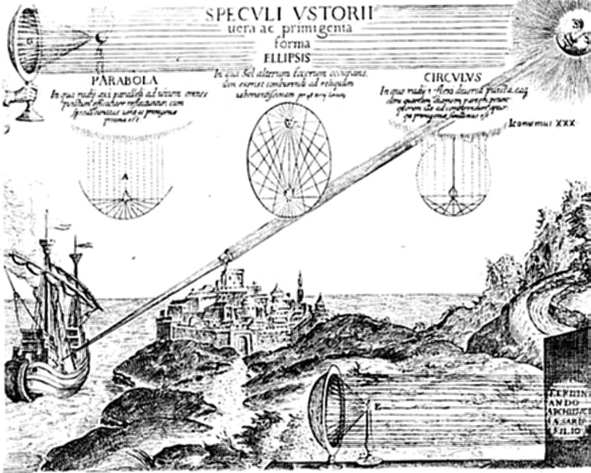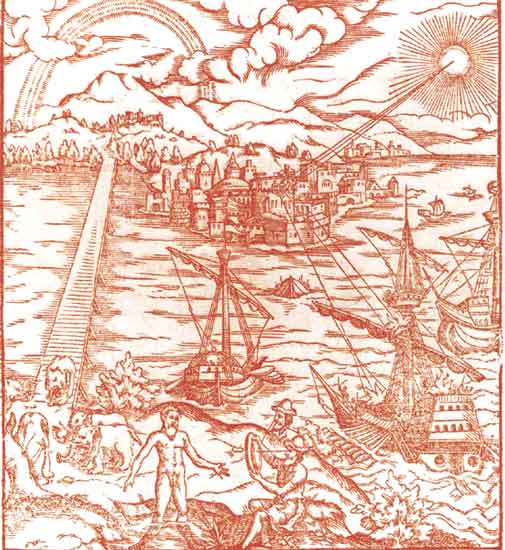|
|
Archimedes: Brennspiegel als Strahlenwaffen, Theorie und Praxis STREPSiADES Have you ever seen a beautiful, transparent stone at the druggists', with which you may kindle fire?
Diocles in burning mirrors, late 2nd century BC, proved that the surface that reflects the rays from the Sun to a single point is a paraboloid of revolution. Constructions of such devices remained of interest as late as the 6th century AD, when Anthemius of Tralles, the architect of the Hagia Sophia at Constantinople, compiled a survey of remarkable mirror configurations. According to Roman writers who chronicled the life of Archimedes, the mathematician was a devoted subject of Hiero ii, ruler of Syracuse, and spent part of his career designing and building weapons to defend Syracuse -- catapults, pulley hoists and levers for disabling enemy ships and siege towers. The ancient historians Polybius, Plutarch and Pliny the Elder all mention such inventions, although none was alive in Archimedes' lifetime. Some Greco-Roman historians also assert that during the Roman siege of Syracuse from 214 to 212 B.C., at the height of the Second Punic War, Archimedes used bronze mirrors to focus sunlight on Roman ships and set them on fire. The Burning mirrors are mentioned by Lucian of Samosata and Galen. There seems to be ample evidence that the optics to do this was well known to Archimedes who was apparently centuries ahead of his time in this as in many other areas of science. E.A. Phillips pointed out that the Science Fiction writer, Arthur C. Clarke, has the last word in his story "A Slight Case of Sunstroke". A South American country sends 50000 well trained soldiers as a cheering section with their soccer team as a big international game. Each soldier has an expensive aluminized program two feet square. When a biased referee makes an unfavorable call, a bugle sounds and 50000 well-trained programs are raised. Zap!
The burning of the Ships, Thesaurus Opticus, Alhazen The study of Mills and Clift Mills and Clift considered the reflective surface that is required to concentrate energy enough to ignite wood in 50 m distance. Their conclusion is: This calculation necessitated an initial investigation of the way in which sunlight is reflected by a plane mirror when the divergence induced by the real angular diameter of the Sun is taken into account. it is established that the patch of reflected sunlight is always greater in size than the mirror, and so (apart from reflection loss) must always be of less intensity than the incident radiation. This patch becomes essentially circular when the equivalent 'f number' of the system is >or=500. its diameter is then given by 0.009* separation between mirror and receiving surface, with the intensity controlled by the area of the mirror. As a result of this divergence, the reflectivity of bronze mirrors, and the angles involved, it is concluded that the combined effort of some 440 men, each wielding a 1 m2 metal mirror, would only just begin to ignite a 1*0.5 m area of a wooden hull at a distance of 50 m. This is such a poor use of manpower and resources that it is concluded this classic story is no more than a myth. Nevertheless it appears that a much smaller minor corps-say 50 men- could inflict severe burns upon selected enemy personnel. A A Mills and R Clift, Reflections of the 'Burning mirrors of Archimedes'. With a consideration of the geometry and intensity of sunlight reflected from plane mirrors, Eur. J. Phys. 13 (November 1992) 268-279 An Experiment was recently performed in Germany (Osnabrück, Bramsche-Kalkriese) in 15 September 2002. it was possible with 500 persons carrying mirrors (each 45cm*45cm ) to ignite a sail of a ship in 50 meter distance in seconds with an estimated 100 KW at the focal point. The visitors of the event called “Mythen & Magie” (Myths and Magic) were excited by the success of the experiment who were instructed by the German Engineer Peter Richter how to align the mirrors. The calculations were performed by the physicist Jörg Buchholz. My opinion is that there is some truth in the Story of Archimedes and the burning mirrors, it is not fiction but we do not know the exact details of this story. Archimedes was a legend because he produced with the the Nobel Physics prize winner proposed in Sicily the use of 360 Parabolic mirrors for the production of electric energy from solar energy. Such devices are used in many places, but Rubbia proposed some new ideas and called the project "Archimedes". Even if the idea of Archimedes is not used as a weapon today it is used for the electric energy production. See also: , An old film with scenes of Archimedes burning mirrors See also:
|

